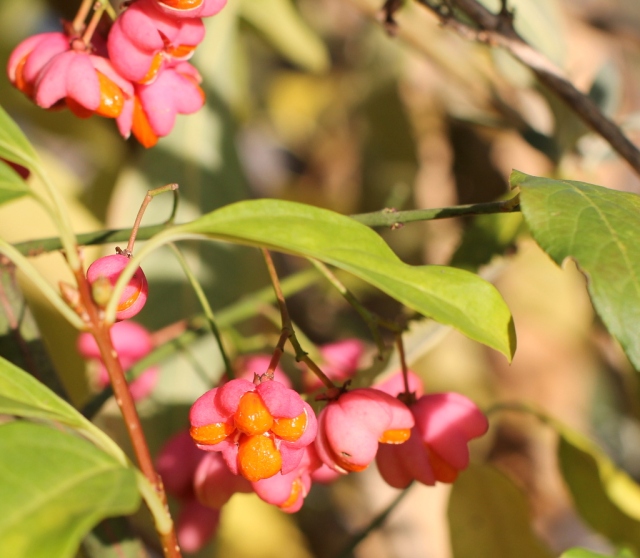
I did not discover that there were spindle trees at the bottom of the garden for several years after we started to live here. This was because they were systematically de-foliated by caterpillars each year and just managed to put on enough growth after their spring stripping to survive until the next annual attack.

The caterpillars that attack the Spindle trees are particularly obnoxious. They form writhing masses inside a pouch that looks as if it has been made by spiders. If you hit the nest with a stick the caterpillars can eject and parachute out hanging on securely by a silken thread. The synchronised descent is very unnerving. The culprit I believe is Yponomeuta cagnagella or Yponomeuta cognatella if you prefer. This is an attractive little night flying moth but I do not want it to defoliate my Spindle trees nor my young silver birch which was likewise defoliated by a very similar looking caterpillar.

I have had to have recourse to Bacillus thuringiensis as I have no hope to hand gather these caterpillars on branches far above my head. I am remarkably pitiless towards anything that threatens the life of my plants. After two years of treatment, including this spring, I have at last seen berries on the trees.

But life for a spindle tree seems to be tough as I noticed that something has been eating the berries! The leaves and the fruit of the spindle tree are poisonous to humans but there is obvious a little worm around that has cut out a little niche for itself feeding off Spindle berries. The trees outside in the woods don’t seem affected so I’m just hoping there is something out there that likes the little worm and it is just a matter of time till it catches up with my newly prospering trees.

The common name for Euonymus europaeus in French is Fusain. This is a reference to the Spindle trees’ use for the charcoal that artists use to make sketches. Artists’ charcoal is called fusain in French, regardless of the source of the charcoal. The natural charcoal is produced by carbonising young branches of trees of a suitable diameter. Other trees including willow and birch can be used but the name seems to have stuck to the Spindle tree. Does the practical Anglo Saxon mind think of the fine, useful implements, like spindles and knitting needles and the Gallic mind think of the benefits to Art that Euonymus europaeus provides?
Or am I just over-thinking this one?

Beautiful pictures of the berries Amelia – they look more like blossom with that gorgeous blue sky. There’s something very oriental about the second shot.
LikeLike
You’re right the colours are more oriental despite the tree being a native European.
LikeLike
Such a lovely tree, I’m thinking of adding one to the boundary as I love the berries. As you say I hope something comes to eat the new pest. Christina
LikeLike
Its nice to have the bright berries at this time of year and I think it is a relatively rapid grower.
LikeLike
The name in French, and its origin, is very interesting. In German the Spindle Tree is called “Pfaffenhuetchen” – Bishop’s Cap! It really does resemble the four-cornered hats worn by Roman-Catholic bishops – the colour too!
LikeLike
I live in SW France where it called bonnet d’Eveque!
LikeLiked by 2 people
By all means over think as I rather enjoyed the results!
LikeLike
Thank you, Rachel.
LikeLike
Interesting post! Your Euonymus is quite different from ours, which has beautiful fall color but is kind of an obnoxious tough shrubby thing that is tough to trim back.
LikeLike
The different species of Euonymus have a very different form but things seem generally different in the States.
LikeLike
We have this pest arrive for the first time this year. It has totally stripped bare one tree/bush. Do they recover and any suggestion on how to treat them or is that futile. We have lots of them in a large garden. Thank you Tony
LikeLike
As I mention in the post, I treated the caterpillars with Bacillus thuringiensis which has been effective. This is a bacteria that will infect and become a parasite of the caterpillar, killing them. It is a method of bio control, I do not know of any contra indication. Host-parasite relationships are usually fairly tight and it is not harmful to humans. You should be able to find this on the shelves of good gardening supply shops – even in France. Amelia
LikeLike
It is certainly not futile to treat them (sorry I missed that first time round). You just have to dissolve a powder of the bacteria and spray the culture onto the leaves. The bacteria will actually reproduce inside the caterpillar and may remain on the trees for future years but it is better to retreat for a second year. Amelia
LikeLike
Thanks for replying, it is just that we have 16 acres and they seem to be popping up everywhere leaving us with what we call ghost trees. And on top of that we have box caterpillars too.
LikeLike
I still think it is worth trying with B. thuringiensis because it also attacks Cydalima perspectalis the box caterpillar. Theoretically, once the caterpillar is killed a new lot of bacilli should be released thus continuing the fight.
LikeLike